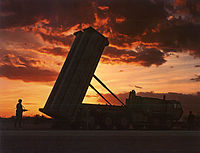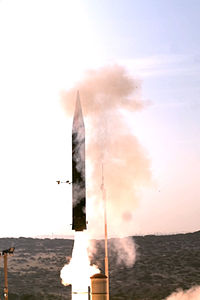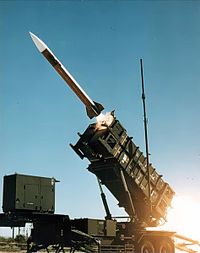Missile Defense Agency
The neutrality of this article is disputed. (November 2020) |
 | |
| Agency overview | |
|---|---|
| Formed | January 2002 |
| Preceding agencies | |
| Jurisdiction | Federal government of the United States |
| Headquarters | Headquarters Command Center, Fort Belvoir, Virginia[1] |
| Employees | Approx. 2500 (3000 with non-MDA support personnel) (2016)[2] |
| Annual budget | $9.187 billion (FY 2021)[3] |
| Agency executives | |
| Parent agency | Department of Defense |
| Website | www |
The Missile Defense Agency (MDA) is the section of the United States government's Department of Defense responsible for developing a layered defense against ballistic missiles. It had its origins in the Strategic Defense Initiative (SDI) which was established in 1983 by Ronald Reagan and which was headed by Lt. General James Alan Abrahamson. Under the Strategic Defense Initiative's Innovative Sciences and Technology Office[5][6][7] headed by physicist and engineer Dr. James Ionson,[8][9][10][11] the investment was predominantly made in basic research at national laboratories, universities, and in industry. These programs have continued to be key sources of funding for top research scientists in the fields of high-energy physics, advanced materials, supercomputing/computation, and many other critical science and engineering disciplines—funding which indirectly supports other research work by top scientists, and which was most politically viable to fund within the Military budget of the United States environment.[12] It was renamed the Ballistic Missile Defense Organization in 1993, and then renamed the Missile Defense Agency in 2002.[13] The current director is U.S. Navy Vice Admiral Jon A. Hill.[14]
Rapid changes in the strategic environment due to the rapid Dissolution of the Soviet Union led, in 1993, to Bill Clinton focusing on theater ballistic missiles and similar threats, and renaming it the Ballistic Missile Defense Organization, BMDO. With another change to a more global focus made by George W. Bush, in 2002 the organization became the Missile Defense Agency.
The Missile Defense Agency is partially or wholly responsible for the development of several ballistic missile defense (BMD) systems, including the Patriot PAC-3, Aegis BMD, THAAD and the Ground-Based Midcourse Defense system. They also led the development of numerous other projects, including the Multiple Kill Vehicle and the newer Multi-Object Kill Vehicle, the Kinetic Energy Interceptor and the Airborne Laser. As the inheritor of the SDI and BMDO work, the MDA continues to fund fundamental research in high-energy physics, supercomputing/computation, advanced materials, and many other science and engineering disciplines.[12]
Mission statement[]

The MDA currently publishes the following mission statement:
"The Missile Defense Agency's (MDA) mission is to develop and deploy a layered Missile Defense System to defend the United States, its deployed forces, allies, and friends from missile attacks in all phases of flight."[15]
The National Defense Authorization Act is cited as the original source of the MDA's mission:
"It is the policy of the United States to maintain and improve an effective, robust layered missile defense system capable of defending the territory of the United States, allies, deployed forces, and capabilities against the developing and increasingly complex ballistic missile threat with funding subject to the annual authorization of appropriations and the annual appropriation of funds for National Missile Defense. National Defense Authorization Act (Public Law 114–328)"[15]
International mission[]

Ballistic Missile Defense Systems (BMDS) must be capable of operating in different regions of the world to ensure the success of the MDA mission. The International Strategy was approved by the MDA Director in 2007. The general strategy for international efforts is:[16]
- Outreach: Communicate the importance of missile defense by promoting worldwide BMDS by sharing information with allies and partners.
- Capability and Interoperability: Identify and integrate U.S and partner systems to create global missile defense system. Promote interoperability among allies.
- Technology: Identify and evaluate possible international technology in support of BMDS capabilities.
- Investment: Identify and execute investment opportunities with allies and partners.
- Workforce: Shape a qualified workforce to execute the MDA International Strategy.
As of 2017 MDA was working on facilities in Germany, Romania, Poland, Japan, Qatar, Saudi Arabia and the United Arab Emirates.[17]
Potential threats against the United States[]
Ballistic missile systems using advanced liquid- or solid- propellant propulsion are becoming more mobile, accurate and capable of striking targets over longer distances and are proliferating worldwide.[18]:pp.18–19/61
- Iran currently has short- and medium- range missiles with guidance systems. Iran's launch of a medium range, solid fuel ballistic missile demonstrates its ability to hit targets in Israel and southern Europe.[19] Iran also successfully launched the Safir Space Launch Vehicle on Feb 2, 2009. It was then speculated that development of an ICBM was not far behind. Intelligence reports that a missile could have been built sometime between 2010 and 2015 perhaps using help from Russian and North Korean technology.[20][21]
- North Korea currently deploys a Nodong ballistic missile capable of hitting Japan and South Korea, and is developing a new intermediate-range ballistic missile (IRBM) which could reach Guam and the Aleutian Islands. They also successfully demonstrated the staging and separation technologies required to launch a Taepo-Dong 2 ICBM which has the capability to reach the United States.[22] The Taepodong missile was first tested in 2006, and failed 40 seconds into midflight. North Korean missiles are notoriously unreliable, and many of the DPRKs missile tests have failed, including the most recent Taepodong-2 launches in 2009 and 2012,[23] and a failed launch of the BM25 Musudan in 2016.[24] On 1 January 2017, North Korea announced its final preparation for a test of an ICBM, for the first time.[25] On 6 March 2017, North Korea launched four missiles from Tongchang-ri,[26] a known long-range missile site at 7:36 a.m. local time, one of which landed in the Sea of Japan, with the remaining three missiles landing in Japan's economic zone.[27] On July 4, 2017 North Korea launched a ballistic missile that had the potential to be an ICBM. It flew into space and landed in the Sea of Japan. "The launch continues to demonstrate that North Korea poses a threat to the United States and our allies," a Pentagon statement said.[28]
- Syria has been identified as a host for Short Range Ballistic Missiles (as it acquires equipment from North Korea and Iran).[18]:p.19/61
Categories[]

MDA divides its systems into four phases: boost; ascent; mid-course; and terminal. Each of these corresponds to a different phase of the threat ballistic missile flight regime. Each phase offers different advantages and disadvantages to a missile defense system (see missile defense classified by trajectory phase), and the geography of each defended area dictates the types of systems which can be employed. The resultant flexible and layered defense approach concept is believed to improve overall defense effectiveness. The more opportunities a system has to neutralize a threat (e.g., by shooting down a missile), the better the chance of success.[citation needed]
Activities have also been categorized as fulfilling the goals of one of five "blocks". For example, "block 4.0" was stated as "Defend Allies and Deployed Forces in Europe from Limited Iranian Long-Range Threats and Expand Protection of U.S. Homeland". It included the US missile defense complex in Poland to be constructed, and the (EMR), currently located at the Ronald Reagan Ballistic Missile Defense Test Site at Kwajalein Atoll, which was to have been modified and relocated to the Czech Republic.[29][30]
On 17 September 2009, the Obama administration scrapped the "block 4.0" plan, in favor of a new so-called "European Phased Adaptive Approach" (EPAA).[31]
Boost phase[]
Can intercept all ranges of missiles, but the missile boost phase is only from one to five minutes. It is the best time to track the missile because it is bright and hot. The missile defense interceptors and sensors must be in close proximity to the launch, which is not always possible. This is the most desirable interception phase because it destroys the missile early in flight at its most vulnerable point and the debris will typically fall on the launching nations' territory.
Ascent phase[]
This is the phase after powered flight but before the apogee. It is significantly less challenging than boost phase intercepts, less costly, minimizes the potential impact of debris and reduces the number of interceptors required to defeat a raid of missiles.
Midcourse phase[]
This phase begins after the booster burns out and begins coasting in space. This can last as long as 20 minutes. Any debris remaining will burn up as it enters the atmosphere. Ground based missile defense systems can defend from long-range and intermediate-range ballistic missiles in this phase. Mobile elements can defend against medium and short ranged missiles in midcourse.
Terminal phase[]
This phase is the last chance to intercept the warhead. This contains the least-desirable Interception Point (IP) because there is little room for error and the interception will probably occur close to the defended target.[16]
Boost phase defense[]
- Kinetic Energy Interceptor (KEI) – in December 2003, MDA awarded a contract to Northrop Grumman for developing and testing. It will have to be launched from a location not too far from the launch site of the target missile (and is therefore less suitable against large countries), it has to be fired very soon after launch of the target, and it has to be very fast itself (6 km/s). In 2009, the Department of Defense and MDA determined the technological issues were excessive and cancelled the program, allocating no funding for it in its later budget submission.[32]
- Boeing YAL-1 Airborne Laser (ABL) – Team ABL proposed and won the contract for this system in 1996. A high-energy laser mounted on a converted 747 airliner was used to intercept a test target in January 2010,[33] and the following month, successfully destroyed two test missiles.[34] While the program has been cancelled due to concerns about its practicality with present technology (while successful the system was still extremely short ranged, likely needing to fly in heavily defended space to make an interception) the YAL-1 served to demonstrate the potential of such a system. The capabilities of being deployed rapidly to any part of the world and of intercepting a large number of missiles would make a future system extremely attractive.
- Network Centric Airborne Defense Element (NCADE) – On September 18, 2008 Raytheon announced it had been awarded a $10 million contract to continue research and development of NCADE, a missile defense system based on the AIM-120 AMRAAM.[35]
One can distinguish disabling the warheads and just disabling the boosting capability. The latter has the risk of "shortfall": damage in countries between the launch site and the target location.
See also APS report.
Ascent phase defense[]
- Ascent phase intercept (API) – Emerging intercept technologies are being developed and designed to defeat launched missiles in their ascent phase.[citation needed] This phase is after the boost phase and prior to the threat missile's apogee (midcourse). The Ascent phase intercept program is still classified so there is little information on it.
Midcourse (ballistic) phase defense[]
- Ground-Based Midcourse Defense (GMD)
- Aegis Ballistic Missile Defense System (Aegis BMD)
- Multiple Kill Vehicle (MKV, originally Miniature Kill Vehicle): the Department of Defense has canceled the MKV program for the time being.[36]
Hypersonic glide phase defense[]
- Glide phase interceptor (GPI)
Terminal phase defense[]
- Terminal High Altitude Area Defense (THAAD)
- PATRIOT Advanced Capability-3 (PAC-3)
- Arrow missile, a joint effort between the U.S. and Israel
- Medium Extended Air Defense System (MEADS), co-developmental program of the United States Department of Defense, Germany and Italy.
List of directors[]
6. Lt Gen Ronald T. Kadish, January 2002
7. Lt Gen Henry Obering, July 2004
8. LTG
9. VADM
10. Lt Gen Samuel A. Greaves, June 2017
11. VADM Jon A. Hill, June 2019
See also[]
- Ground-Based Interceptor#Next Generation Interceptor (NGI)
- Joint Functional Component Command for Integrated Missile Defense
- United States Strategic Command
- National Missile Defense
References[]
- ^ "MDA Breaks Ground on New Headquarters Facility" (PDF).
- ^ Missile Defense Agency Notification and Federal Employee Antidiscrimination and Retaliation Act (NoFEAR) Fiscal Year 2016 Report (PDF) (Report). Missile Defense Agency. 2016. p. 1. Retrieved July 11, 2021.
- ^ Missile Defense Agency Budget Estimates Overview Fiscal Year (FY) 2021 (PDF) (Report). Missile Defense Agency. 2020. p. 1, 15. Retrieved July 11, 2021.
- ^ "MDA Leadership". mda.mil. Missile Defense Agency. Retrieved July 11, 2021.
- ^ "SDIO Funds Research". MIT: The Tech. November 5, 1985.
- ^ "Special Presentation: Innovative Science and Technology Programs". SPIE – Digital Library. June 3, 1988. doi:10.1117/12.947548.
- ^ "Star War's Inc". Inc. Magazine. April 1987.
- ^ "Washington's Ins & Outs: Ionson and Mense Leave SDIO". Physics Today. June 1988. doi:10.1063/1.2811448.
- ^ "Low Profile for SDI Work on Campus". The Scientist Magazine. May 1988.
- ^ "Ionson Counters SDI Dispute". MIT: The Tech. November 1985.
- ^ "Ionson Defends SDI Program". MIT: The Tech. October 1985.
- ^ Jump up to: a b 85-25: National Policy on Transfer of Scientific, Technical and Engineering Information, Security Innovation for Estate Protection
- ^ "MDA History". mda.mil. January 23, 2019. Retrieved May 31, 2019.
- ^ "Missile Defense Agency Completes Change of Responsibility Ceremony". www.mda.mil (Press release). Fort Belvoir, Virginia: Missile Defense Agency. May 31, 2019. Retrieved May 31, 2019.
- ^ Jump up to: a b MDA (2019). Our Mission. Retrieved on 2019-12-21 from https://www.mda.mil/about/mission.html.
- ^ Jump up to: a b "Testing: Building Confidence" (PDF). Missile Defense Agency. 2009. Retrieved 2009-12-23.
- ^ "New US Missile Defence Agency Bases To Be Constructed Around World". www.defenseworld.net. Digitalwriters Media Pvt. Ltd. 24 May 2017. Retrieved 25 May 2017.
- ^ Jump up to: a b "Ballistic Missile Defense Review, 26 Jan 2010" (PDF). defense.gov. 26 January 2010. Retrieved 22 December 2018.
- ^ "Iran tests longest range missiles". BBC News. 2009-09-28. Retrieved 2009-12-23.
- ^ Hildreth, Steven A. (2008-07-21). "Iran's Ballistic Missile Programs: An Overview". Congressional Research Service. Retrieved 2009-12-23.
- ^ "U.S. says Iran rocket test breaches U.N. resolution". yahoo.com. Retrieved 10 April 2018.
- ^ "North Korea's missile programme". BBC News. 2009-05-27. Retrieved 2009-12-23.
- ^ "The 100th Missile Defense Brigade: A decade of transformation and mission success". army.mil. Retrieved 10 April 2018.
- ^ On North Korea’s failed Musudan launch Archived 2018-11-06 at the Wayback Machine accessdate=2016-06-03
- ^ PM Abe: North Korea launched four ballistic missiles .nytimes.com/2017/01/01/world/asia/north-korea-intercontinental-ballistic-missile-test-kim-jong-un.html Choe Sang-Hun, (1 Jan 2017) "North Korea Will Test Intercontinental Ballistic Missile, Kim Says" New York Times[permanent dead link]
- ^ PM Abe: North Korea launched four ballistic missiles[dead link] accessdate=2017-03-05
- ^ Washington Post North Korea launches another missile, perhaps one that can reach U.S. accessdate=2017-03-05
- ^ Barbara Starr and Ryan Browne. "As US, SK drill, Tillerson seeks action on NK". CNN. Retrieved 2017-07-06.
- ^ "Ballistic Missile Defense System". GlobalSecurity. Retrieved 2008-11-07.
- ^ G. Lewis and T. Postol (May–June 2008). "The European missile defense folly". Bulletin of the Atomic Scientists. 64 (2): 33. Bibcode:2008BuAtS..64b..32L. doi:10.2968/064002009.
- ^ "United States European Phased Adaptive Approach (EPAA) and NATO Missile Defense". U.S. Department of State. 2011-05-03. Retrieved 2013-07-05.
- ^ "Kinetic Energy Interceptors Program Element 0603886C Budget Item Justification" (PDF). May 2009.
- ^ Airborne Laser (ABL) 2010 Archived 2010-01-28 at the Wayback Machine. US Missile Defense Agency, January 10, 2010. Retrieved: January 25, 2010.
- ^ "U.S. successfully tests airborne laser on missile". Reuters. Feb 12, 2010.
- ^ "Raytheon Awarded $10 million to Develop New Missile Defense Interceptor". Raytheon. Sep 18, 2008.
- ^ "President's Budget Submission for Program Element 0603894C" (PDF). Apr 27, 2009.
External links[]
| Wikimedia Commons has media related to Missile Defense Agency. |
- Missile Defense Agency
- United States Department of Defense agencies
- Government agencies established in 2002
- 2002 establishments in the United States
